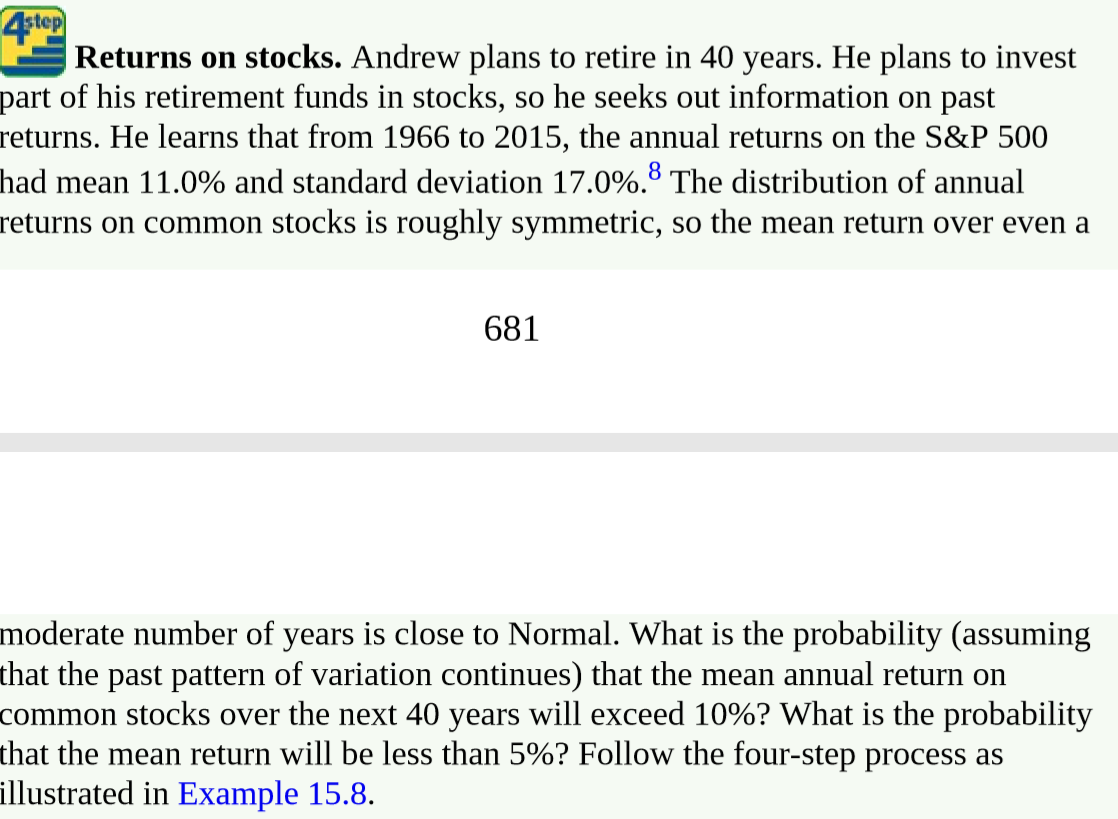4step Returns on stocks. Andrew plans to retire in 40 years. He plans to invest part of his retirement funds in stocks, so he seeks out information on past returns. He learns that from 1966 to 2015, the annual returns on the S&P 500 had mean 11.0% and standard deviation 17.0%.8 The distribution of annual returns on common stocks is roughly symmetric, so the mean return over even a 681 moderate number of years is close to Normal. What is the probability (assuming that the past pattern of variation continues) that the mean annual return on common stocks over the next 40 years will exceed 10%? What is the probability that the mean return will be less than 5%? Follow the four-step process as illustrated in Example 15.8.
4step Returns on stocks. Andrew plans to retire in 40 years. He plans to invest part of his retirement funds in stocks, so he seeks out information on past returns. He learns that from 1966 to 2015, the annual returns on the S&P 500 had mean 11.0% and standard deviation 17.0%.8 The distribution of annual returns on common stocks is roughly symmetric, so the mean return over even a 681 moderate number of years is close to Normal. What is the probability (assuming that the past pattern of variation continues) that the mean annual return on common stocks over the next 40 years will exceed 10%? What is the probability that the mean return will be less than 5%? Follow the four-step process as illustrated in Example 15.8.
Glencoe Algebra 1, Student Edition, 9780079039897, 0079039898, 2018
18th Edition
ISBN:9780079039897
Author:Carter
Publisher:Carter
Chapter10: Statistics
Section10.4: Distributions Of Data
Problem 19PFA
Related questions
Question
I believe the solutions on the website is wrong as the equation I attached on the 2nd image does not appear anywhere in my textbook. It does, however, have the same equation but it only divides σ it does not divide σ/√N. Can you please help me with the answer to this question.


Transcribed Image Text:4step
Returns on stocks. Andrew plans to retire in 40 years. He plans to invest
part of his retirement funds in stocks, so he seeks out information on past
returns. He learns that from 1966 to 2015, the annual returns on the S&P 500
had mean 11.0% and standard deviation 17.0%.8 The distribution of annual
returns on common stocks is roughly symmetric, so the mean return over even a
681
moderate number of years is close to Normal. What is the probability (assuming
that the past pattern of variation continues) that the mean annual return on
common stocks over the next 40 years will exceed 10%? What is the probability
that the mean return will be less than 5%? Follow the four-step process as
illustrated in Example 15.8.
Expert Solution
This question has been solved!
Explore an expertly crafted, step-by-step solution for a thorough understanding of key concepts.
This is a popular solution!
Trending now
This is a popular solution!
Step by step
Solved in 3 steps with 4 images

Knowledge Booster
Learn more about
Need a deep-dive on the concept behind this application? Look no further. Learn more about this topic, statistics and related others by exploring similar questions and additional content below.Recommended textbooks for you

Glencoe Algebra 1, Student Edition, 9780079039897…
Algebra
ISBN:
9780079039897
Author:
Carter
Publisher:
McGraw Hill

Glencoe Algebra 1, Student Edition, 9780079039897…
Algebra
ISBN:
9780079039897
Author:
Carter
Publisher:
McGraw Hill